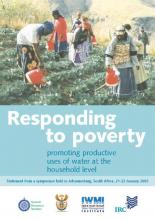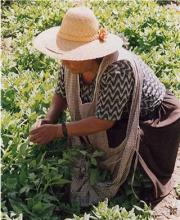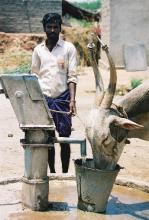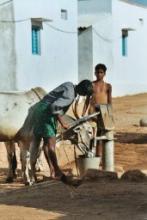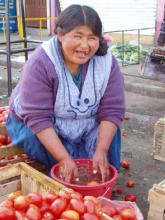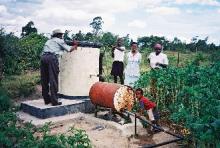Document
A meeting of minds of Johannesburg brought together a multi-disciplinary group of practitioners, researchers, and policy-makers from 14 countries across Africa, Asia, South and North America, and Europe. This short document records the most important findings, beliefs, and recommendations of the participants that were captured in a statement at the symposium.
This case study on household level productive uses of water in Bolivia focuses on two key issues:
- The importance of productive activities in household water use, and the associated contributions water makes to livelihoods, and
- The potential for water resources conflicts over allocations for household level productive uses.
The case study was carried out around the rapidly growing city of Cochabamba in central Bolivia. The study areas were Tarata, a small town to the south-east, and Tiquipaya, which is located on the peri-urban fringes of the city.
Household water use patterns
One part of the case study involved investigation of household water-use patterns in Tarata and Tiquipaya. This research examined the multiple use of domestic water supplies, and the use by families of multiple sources to meet their water needs for both domestic and productive activities. As the city of Cochabamba expands, it is argued by the authors that productive water uses such as irrigation of gardens ( huertas) are likely to make significant demands upon new domestic water supply systems. These uses are equally likely to have an important impact, whether positive or negative depending on your viewpoint, on the overall availability of water resources as well as on the livelihoods of urban and peri-urban water users.
Key findings
- At the household level, studies show that a significant proportion (roughly half) of so-called ‘domestic’ water supplied in Tarata and Tiquipaya was used by the case study families for productive activities: including irrigation of huertas, watering livestock or other enterprises. Equally, irrigation water is used, at times, for domestic purposes.
- In some cases domestic water provides the sole source and makes small-scale irrigation of huertas or other enterprises possible. More often domestic water provides an important supplementary source and reduces risks in irrigated cropping where canal water is inadequate or unreliable. In general, non-domestic sources provided a far greater quantity of water for productive purposes, but the strengths of domestic water supplies are their availability (often 24 hours a day), reliability, and convenience.
- The need for multiple uses was recognised by the water supply utility in Tarata who in addition to supplying safe water from groundwater sources through the domestic network, sought to supply additional (and cheaper) water for urban and peri-urban agriculture through a system of canals. Similarly, the designers of the proposed EPSA-Macoti water and sanitation system in Tiquipaya should take account of the relatively high demand (and potential) for the use of domestic water for productive activities in Tiquipaya and the need to plan in an integrated way for multiple uses from multiple sources. Otherwise, opportunities to support livelihoods will be lost and high per capita use of water for productive activities may compromise supplies in other tail-end parts of the system.
Conflict over water allocations
The second part of the case study investigated a serious conflict in Tarata over allocations of water for household level productive uses around the town. Disputes came to a head in 2002 over the rights to use water for urban and peri-urban agriculture from a multiple purpose water supply system (Laka Laka). The Laka Laka dam was planned to provide water for a large irrigation scheme and to meet the basic needs of domestic users in the town, but not specifically for productive water uses within the urban area.
Almost 5% of the estimated reservoir yield (or 10% of the storage capacity) was originally allocated for urban water supply, but this could not be used as drinking water due to the poor water quality and high costs of treatment. The urban community organised to utilise this water, on the basis of advice they received from local government supporting their proposals, for irrigation of huertas instead. An organisation was formed to develop the infrastructure to supply this water to huertas. However, there were violent conflicts with farmers from the irrigation scheme ( regantes)who were determined to protect their irrigation water rights.
Key findings
- The use of water from the Laka Laka reservoir for urban agriculture was in the opinion of the regantes, against the agreed rules for operation of the multiple purpose scheme. The construction of a pipeline to irrigate huertas in the town and renewed use of the water from the dam by the town after a gap of four years was a direct cause of the conflict, aggravated by the lack of overarching legislation and norms, and the historic rivalry between the municipalities of Tarata and Arbieto (where much of the irrigated land is located).
- The declining yield of the reservoir due to severe sedimentation is likely to lead to further pressures on the scarce water resources in the area, and potentially continued or more serious conflict, unless strong institutions are able to manage the diminishing resource and resolve the conflicting interests. Potential solutions to help minimise or resolve the existing conflict in Tarata could include better information sharing between key stakeholders (including reliable information on declining future water availability due to sedimentation), more transparency in the operations of the key institutions, general strengthening in institutional capacities to deal with conflicts, and in the irrigated areas especially, measures to introduce incentives to use water more efficiently.
- Although every conflict over access to contested resources has many local characteristics, some more widely applicable lessons can be learnt from the disputes in Tarata. Firstly, improved domestic water supplies, in this case following construction of a reservoir and associated infrastructure, will in certain cases lead to increased water use for urban agriculture and other productive uses. Secondly, productive water uses at the household level are, as in Tarata, rarely considered in planning. These needs should be properly considered in the project design for improved water supplies and multi-purpose projects, and the rights to water for these uses should be clearly negotiated and agreed in multiple-purpose projects.
- Whether urban agriculture, or other productive uses of water around homesteads, should be explicitly encouraged within domestic or multiple-purpose water supply projects should amongst other factors be based upon: an assessment of local needs; comparisons of the efficiency, benefits and costs of productive water uses; assessment of contributions to (or disadvantages for) cost recovery and sustainability; and an understanding of whether there are particular benefits for the poor.
Case Study Documents
Read more about this case study in the following documents:
Multiple sources for multiple uses: Household case studies of water use around Cochabamba, Bolivia
- Case study paper (English)
- Case study paper (Spanish)
- Full report
Livelihoods in conflict: disputes over water for household-level productive uses in Tarata, Bolivia
- Case study paper (English)
- Case study paper (Spanish)
- Full report
Contacts
This case study was undertaken by the Andean Center for Water Management and Water Use (Centro-AGUA) at the Universidad Mayor de San Simon in Cochabamba, Bolivia. For further information please contact Rocio Bustamante at Centro-AGUA (vhrocio@entelnet.bo) or John Butterworth at IRC (butterworth@irc.nl ) .
Dr Patrick Moriarty (IRC) and Dr John Butterworth (NRI) (2003)
This IRC Thematic Overview Paper (TOP) looks at the broader range of uses which people allocate to their water supplies. It looks in particular at productive activities and micro-enterprises within households in villages, towns and cities in developing countries.
It examines how domestic water supplies can become productive and how this can contribute to peoples' livelihoods, particularly those of women and the poor, thus increasing the impact of an intervention. This approach challenges the traditional assumption that water delivered to people's homes should be for domestic purposes alone. At its heart lies the belief - supported by a rapidly increasing body of empirical evidence - that by adopting a broader perspective the WATSAN sector can more effectively contribute to tackling rural and urban poverty and at the same time better address perennial WATSAN problems such as sustainability and cost recovery.
Target audience: Policy makers and sector specialists interested in the issue of productive uses of water.
A succinct introduction to this TOP and its PDF copy may be accessed from the IRC website.
Joep Verhagen, A.J. James, Christine van Wijk, Reema Nanavatty, Mita Parikh, Mihir Bhatt (2004)
In general, women continue to have limited opportunities to influencing the design and operations of domestic water supply projects for their productive use of water and time. This report describes the findings of a pilot research project carried out in Gujarat, India. Together with the women and men of Gujarat, the relevance of women's productive use of water, the time gains for the family, the impact of such uses on gender relations, and the implications for policies, project design and operations management are among the issues that were examined.
The full report is available for download from the IRC website.
The study was carried out from June 1999 to April 2001 by the Foundation for Public Interest (FPI), the Self-Employed Women's Association (SEWA), and the IRC International Water and Sanitation Centre. The Swedish International Development Authority (Sida) financed the research.
Is something missing from your work in water supply? Do individuals and communities that you work with use their water supplies for multiple purposes? Are you challenged by how to help the poor gain access to water (beyond 'traditional' domestic or field-scale irrigation needs) for activities that generate food and income like fruit and vegetable production, keeping livestock, brick-making and building, and a wide range of informal micro-enterprises? Do you search for ways to improve cost-recovery?
Beyond domestic contains:
- evidence of how multi-purpose water supplies can help poor women and men to build sustainable livelihoods and fight poverty;
- analysis of the key issues relating to productive uses of water at the household level;
- details of practical experience on how to cater to the demand for productive water;
- links to further information and contacts.
The book will inspire and support professionals seeking to move beyond sectoral boundaries in domestic or irrigation water supply, and contains many suggestions for an agenda of policy change, implementation and further research.
Beyond domestic is jointly published by IRC International Water and Sanitation Centre, the Natural Resources Institute (NRI) and the International Water Management Institute (IWMI).
The full publication may be downloaded from the IRC website. A hard copy of the publication is also available. Please contact IRC at publications@irc.nl
This case study provides an overview of the work and key interventions made by the NGO Pump Aid at the household (HH) and community levels in some parts of Zimbabwe. Prepared by Ian Thorpe, the case study entitled 'Appropriate technology for sustainable water systems in Zimbabwe', succintly discusses the technological approach adopted by the NGO (i.e. elephant pump) in providing communities with reliable access to clean, safe water for drinking and irrigation; the participatory approaches that are at the crux of its work and the success of the project; and its application of multiple/productive use of water.

